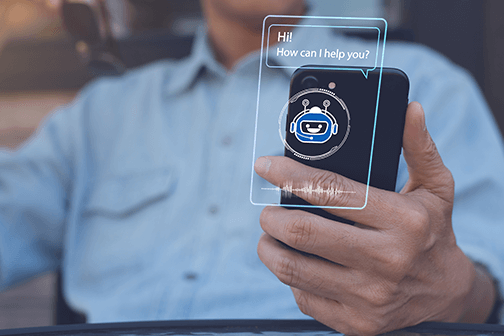Chatbots are fundamentally changing the way that companies create customer experiences. In the contact center, for example, chatbots have the potential to handle routine requests and increase speed to resolution. They can also give agents more time to focus on complex or higher-value interactions, with a long-term positive impact on customer relationships.
According to a recent PwC study, close to 80% of American consumers say that “speed, convenience, knowledgeable help, and friendly service” are critical to the customer experience. A well-designed conversational chatbot can play a key role in meeting these expectations—reducing delay through automation and making it easier for brands to offer swift, seamless service.
As voice recognition technology advances and becomes more accessible to companies of all sizes, there are two chatbot options to choose from: text-based chatbots and voice-enabled chatbots. Which is the future?
What is a chatbot, exactly?
Before considering the potential uses of a voice recognition chatbot, it’s important to understand how this type of technology works. Chatbots are software solutions that humans can interact with using text-based queries or spoken language or a combination of both.
More intelligent chatbots (those powered by AI) use capabilities such as natural language processing and machine learning to extract meaning from customer input, provide the most relevant response, and learn from experience to continually refine and improve the customer experience.
How text-based chatbots work
As the name suggests, a text-based chatbot is the one that interacts and communicates through text or messaging. This type of bot can be useful when programmed to accurately understand the customer’s need and provide immediate outcomes; or gather valuable feedback and ensure customers are engaged quickly.
Text-based chatbots are typically used to handle routine customer interactions and are often merged with messaging apps, social media, SMS and other channels.
But there’s a catch. Because they are text-based, these chatbot solutions require customers to type or tap in their queries and commands. This can, by nature, require more time and effort than a voice based chatbot.
How voice-enabled chatbots are changing the game
A voice recognition chatbot – also known as a text to speech chatbot – uses pre-recorded answers and text to speech capabilities to address customer queries. There are two ways to program these:
- Users command the chatbots in either oral or written form and then reply with their voice.
- Users make commands with their voice only, no text. Well known examples are Siri and Alexa.
A voice based chatbot text to speech solution can be far more fluid and offer a more natural user experience. Rather than just buttons, links, or graphics, the customer uses spoken words to guide the conversation.
What’s really neat is that the capabilities of these bots continue to evolve. Thanks to in-built AI, they can learn from experience. They can also mix a conversational user interface (UI) with a graphical UI—combining the intuitive nature of speech with the immediate gratification of graphics.
Voice-enabled chatbots vs. text-based chatbots
The key to choosing between voice-enabled and text-to-speech bots and those that only provide a text-based UI is to ensure you understand the preferences of your customers.
A PwC survey found that around 71% of consumers prefer to use voice searches to conduct a query over the traditional method of typing. And recent reports estimate that 112 million people in the US will use a voice assistant at least monthly, up 10% from the previous year.
Driving customer engagement with voice
Voice use is particularly relevant to people who are multitasking and need answers quickly, without having to put down what they’re doing and type or press a button. Voice-enabled chatbots are that next step forward for continuous, relevant customer engagement. They can be available 24/7 online and ready to serve anyone, anywhere, hands-free.
Give Your Chatbot a Voice
Voice-enabled customer experiences are the future. The LumenVox Automated Speech Recognizer and NLU Gateway can give your chatbot a voice, boosting your CX strategy and increasing operational efficiency. To learn more, contact us here.





